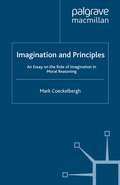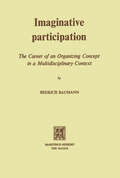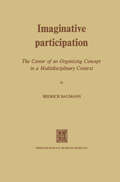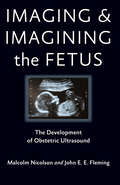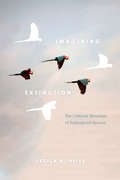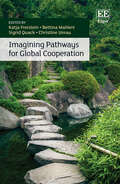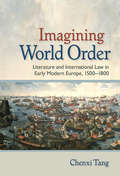- Table View
- List View
Imaginary Worlds and Real Ethics in Japanese Fiction: Case Studies in Novel Reflexivity
by Professor or Dr. Christopher WeinbergerCan novels contribute to the ethical lives of readers? What responsibilities might they bear in representing others? Are we ethically accountable for how we read fiction? This study takes up modern Japanese fiction and metafiction, subjects overwhelmingly ignored by Anglophone scholarship on novel ethics, to discover pioneering answers to these and other questions. Each chapter offers new readings of major works of modern Japanese literature (1880s through 1920s) that experiment with the capacity of novel narration to involve readers in ethically freighted encounters. Christopher Weinberger shows that Mori Ogai and Akutagawa Ryunosuke help to address key issues in new ethical theories today: debates about the roles that identification and empathy play in novel ethics; concerns about the representation of “otherness” and alterity in novels; divergence between cognitive and affective theories of ethics; widespread disagreement about what novel ethics obtain in the experience of reading, the effects of reading, or the form or content of novel representation; and, finally, concerns with bias and appropriation in the study of world literature. Concluding with a jump to the present, Imaginary Worlds and Real Ethics in Japanese Fiction puts on display a startling continuity between the methods of Japan's modern novel progenitors and those of novelists at the forefront of global literature today, especially Haruki Murakami. Ultimately, this book models an original approach to ethical criticism while demonstrating the relevance of modern Japanese fiction for rethinking contemporary theories of the novel.
Imaginary Worlds and Real Ethics in Japanese Fiction: Case Studies in Novel Reflexivity
by Professor or Dr. Christopher WeinbergerCan novels contribute to the ethical lives of readers? What responsibilities might they bear in representing others? Are we ethically accountable for how we read fiction? This study takes up modern Japanese fiction and metafiction, subjects overwhelmingly ignored by Anglophone scholarship on novel ethics, to discover pioneering answers to these and other questions. Each chapter offers new readings of major works of modern Japanese literature (1880s through 1920s) that experiment with the capacity of novel narration to involve readers in ethically freighted encounters. Christopher Weinberger shows that Mori Ogai and Akutagawa Ryunosuke help to address key issues in new ethical theories today: debates about the roles that identification and empathy play in novel ethics; concerns about the representation of “otherness” and alterity in novels; divergence between cognitive and affective theories of ethics; widespread disagreement about what novel ethics obtain in the experience of reading, the effects of reading, or the form or content of novel representation; and, finally, concerns with bias and appropriation in the study of world literature. Concluding with a jump to the present, Imaginary Worlds and Real Ethics in Japanese Fiction puts on display a startling continuity between the methods of Japan's modern novel progenitors and those of novelists at the forefront of global literature today, especially Haruki Murakami. Ultimately, this book models an original approach to ethical criticism while demonstrating the relevance of modern Japanese fiction for rethinking contemporary theories of the novel.
Imagination and Principles: An Essay on the Role of Imagination in Moral Reasoning
by M. CoeckelberghWhat does it mean to say that imagination plays a role in moral reasoning, and what are the theoretical and practical implications? Engaging with three traditions in moral theory and confronting them with three contexts of moral practice, this book comprehensively explores these questions and the relation between imagination and principles.
Imaginative Participation: The Career of an Organizing Concept in a Multidisciplinary Context
by B. BaumannI am Czech. In 1948 I graduated from ancient Charles' University at Prague. In 1970 I came to Canada, the country of my choice, from New Zealand where I had taught two years at the University of Canter bury in Christchurch. This work was begun after I left Europe. It is intended as contribution to contemporary sociological and social psy chological theory, or theories. For a very long time in my native country I was intellectually a Jack of-alI-trades. Before coming to sociology I spent two decades of study and research in the fields of philosophy, history and imaginative literature. Looking back I view this not as wasted time, but as an extraordinary introduction to the study of society, of man in society and of society in man. There are many links between these areas of scientific inquiry which I would not have been able to make had I not had this multi disciplinary experience. In each of my lives, past and present, I have been for a number of reasons marginal to my fellow men, marginal in several respects. In my native land I refused to conform to the line of the ruling political party. I became a "non-person" in all that implies in a totalitarian regime.
Imaginative Participation: The Career of an Organizing Concept in a Multidisciplinary Context
by NA BaumannI am Czech. In 1948 I graduated from ancient Charles' University at Prague. In 1970 I came to Canada, the country of my choice, from New Zealand where I had taught two years at the University of Canter bury in Christchurch. This work was begun after I left Europe. It is intended as contribution to contemporary sociological and social psy chological theory, or theories. For a very long time in my native country I was intellectually a Jack of-all-trades. Before coming to sociology I spent two decades of study and research in the fields of philosophy, history and imaginative literature. Looking back I view this not as wasted time, but as an extraordinary introduction to the study of society, of man in society and of society in man. There are many links between these areas of scientific inquiry which I would not have been able to make had I not had this multi disciplinary experience. In each of my lives, past and present, I have been for a number of reasons marginal to my fellow men, marginal in several respects. In my native land I refused to conform to the line of the ruling political party. I became a "non-person" in all that implies in a totalitarian regime.
Imaging and Imagining the Fetus: The Development of Obstetric Ultrasound
by Malcolm Nicolson John E. FlemingTo its proponents, the ultrasound scanner is a safe, reliable, and indispensable aid to diagnosis. Its detractors, on the other hand, argue that its development and use are driven by the technological enthusiasms of doctors and engineers (and the commercial interests of manufacturers) and not by concern to improve the clinical care of women. In some U.S. states, an ultrasound scan is now required by legislation before a woman can obtain an abortion, adding a new dimension to an already controversial practice. Imaging and Imagining the Fetus engages both the development of a modern medical technology and the concerted critique of that technology.Malcolm Nicolson and John Fleming relate the technical and social history of ultrasound imaging—from early experiments in Glasgow in 1956 through wide deployment in the British hospital system by 1975 to its ubiquitous use in maternity clinics throughout the developed world by the end of the twentieth century. Obstetrician Ian Donald and engineer Tom Brown created ultrasound technology in Glasgow, where their prototypes were based on the industrial flaw detector, an instrument readily available to them in the shipbuilding city. As a physician, Donald supported the use of ultrasound for clinical purposes, and as a devout High Anglican he imbued the images with moral significance. He opposed abortion—decisions about which were increasingly guided by the ultrasound technology he pioneered—and he occasionally used ultrasound images to convince pregnant women not to abort the fetuses they could now see.Imaging and Imagining the Fetus explores why earlier innovators failed where Donald and Brown succeeded. It also shows how ultrasound developed into a "black box" technology whose users can fully appreciate the images they produce but do not, and have no need to, understand the technology, any more than do users of computers. These "images of the fetus may be produced by machines," the authors write, "but they live vividly in the human imagination."
Imaging and Imagining the Fetus: The Development of Obstetric Ultrasound
by Malcolm Nicolson John E. FlemingTo its proponents, the ultrasound scanner is a safe, reliable, and indispensable aid to diagnosis. Its detractors, on the other hand, argue that its development and use are driven by the technological enthusiasms of doctors and engineers (and the commercial interests of manufacturers) and not by concern to improve the clinical care of women. In some U.S. states, an ultrasound scan is now required by legislation before a woman can obtain an abortion, adding a new dimension to an already controversial practice. Imaging and Imagining the Fetus engages both the development of a modern medical technology and the concerted critique of that technology.Malcolm Nicolson and John Fleming relate the technical and social history of ultrasound imaging—from early experiments in Glasgow in 1956 through wide deployment in the British hospital system by 1975 to its ubiquitous use in maternity clinics throughout the developed world by the end of the twentieth century. Obstetrician Ian Donald and engineer Tom Brown created ultrasound technology in Glasgow, where their prototypes were based on the industrial flaw detector, an instrument readily available to them in the shipbuilding city. As a physician, Donald supported the use of ultrasound for clinical purposes, and as a devout High Anglican he imbued the images with moral significance. He opposed abortion—decisions about which were increasingly guided by the ultrasound technology he pioneered—and he occasionally used ultrasound images to convince pregnant women not to abort the fetuses they could now see.Imaging and Imagining the Fetus explores why earlier innovators failed where Donald and Brown succeeded. It also shows how ultrasound developed into a "black box" technology whose users can fully appreciate the images they produce but do not, and have no need to, understand the technology, any more than do users of computers. These "images of the fetus may be produced by machines," the authors write, "but they live vividly in the human imagination."
Imagining Extinction: The Cultural Meanings of Endangered Species
by Ursula K. HeiseWe are currently facing the sixth mass extinction of species in the history of life on Earth, biologists claim—the first one caused by humans. Activists, filmmakers, writers, and artists are seeking to bring the crisis to the public’s attention through stories and images that use the strategies of elegy, tragedy, epic, and even comedy. Imagining Extinction is the first book to examine the cultural frameworks shaping these narratives and images. Ursula K. Heise argues that understanding these stories and symbols is indispensable for any effective advocacy on behalf of endangered species. More than that, she shows how biodiversity conservation, even and especially in its scientific and legal dimensions, is shaped by cultural assumptions about what is valuable in nature and what is not. These assumptions are hardwired into even seemingly neutral tools such as biodiversity databases and laws for the protection of endangered species. Heise shows that the conflicts and convergences of biodiversity conservation with animal welfare advocacy, environmental justice, and discussions about the Anthropocene open up a new vision of multispecies justice. Ultimately, Imagining Extinction demonstrates that biodiversity, endangered species, and extinction are not only scientific questions but issues of histories, cultures, and values.
Imagining Extinction: The Cultural Meanings of Endangered Species
by Ursula K. HeiseWe are currently facing the sixth mass extinction of species in the history of life on Earth, biologists claim—the first one caused by humans. Activists, filmmakers, writers, and artists are seeking to bring the crisis to the public’s attention through stories and images that use the strategies of elegy, tragedy, epic, and even comedy. Imagining Extinction is the first book to examine the cultural frameworks shaping these narratives and images. Ursula K. Heise argues that understanding these stories and symbols is indispensable for any effective advocacy on behalf of endangered species. More than that, she shows how biodiversity conservation, even and especially in its scientific and legal dimensions, is shaped by cultural assumptions about what is valuable in nature and what is not. These assumptions are hardwired into even seemingly neutral tools such as biodiversity databases and laws for the protection of endangered species. Heise shows that the conflicts and convergences of biodiversity conservation with animal welfare advocacy, environmental justice, and discussions about the Anthropocene open up a new vision of multispecies justice. Ultimately, Imagining Extinction demonstrates that biodiversity, endangered species, and extinction are not only scientific questions but issues of histories, cultures, and values.
Imagining Extinction: The Cultural Meanings of Endangered Species
by Ursula K. HeiseWe are currently facing the sixth mass extinction of species in the history of life on Earth, biologists claim—the first one caused by humans. Activists, filmmakers, writers, and artists are seeking to bring the crisis to the public’s attention through stories and images that use the strategies of elegy, tragedy, epic, and even comedy. Imagining Extinction is the first book to examine the cultural frameworks shaping these narratives and images. Ursula K. Heise argues that understanding these stories and symbols is indispensable for any effective advocacy on behalf of endangered species. More than that, she shows how biodiversity conservation, even and especially in its scientific and legal dimensions, is shaped by cultural assumptions about what is valuable in nature and what is not. These assumptions are hardwired into even seemingly neutral tools such as biodiversity databases and laws for the protection of endangered species. Heise shows that the conflicts and convergences of biodiversity conservation with animal welfare advocacy, environmental justice, and discussions about the Anthropocene open up a new vision of multispecies justice. Ultimately, Imagining Extinction demonstrates that biodiversity, endangered species, and extinction are not only scientific questions but issues of histories, cultures, and values.
Imagining Extinction: The Cultural Meanings of Endangered Species
by Ursula K. HeiseWe are currently facing the sixth mass extinction of species in the history of life on Earth, biologists claim—the first one caused by humans. Activists, filmmakers, writers, and artists are seeking to bring the crisis to the public’s attention through stories and images that use the strategies of elegy, tragedy, epic, and even comedy. Imagining Extinction is the first book to examine the cultural frameworks shaping these narratives and images. Ursula K. Heise argues that understanding these stories and symbols is indispensable for any effective advocacy on behalf of endangered species. More than that, she shows how biodiversity conservation, even and especially in its scientific and legal dimensions, is shaped by cultural assumptions about what is valuable in nature and what is not. These assumptions are hardwired into even seemingly neutral tools such as biodiversity databases and laws for the protection of endangered species. Heise shows that the conflicts and convergences of biodiversity conservation with animal welfare advocacy, environmental justice, and discussions about the Anthropocene open up a new vision of multispecies justice. Ultimately, Imagining Extinction demonstrates that biodiversity, endangered species, and extinction are not only scientific questions but issues of histories, cultures, and values.
Imagining Extinction: The Cultural Meanings of Endangered Species
by Ursula K. HeiseWe are currently facing the sixth mass extinction of species in the history of life on Earth, biologists claim—the first one caused by humans. Activists, filmmakers, writers, and artists are seeking to bring the crisis to the public’s attention through stories and images that use the strategies of elegy, tragedy, epic, and even comedy. Imagining Extinction is the first book to examine the cultural frameworks shaping these narratives and images. Ursula K. Heise argues that understanding these stories and symbols is indispensable for any effective advocacy on behalf of endangered species. More than that, she shows how biodiversity conservation, even and especially in its scientific and legal dimensions, is shaped by cultural assumptions about what is valuable in nature and what is not. These assumptions are hardwired into even seemingly neutral tools such as biodiversity databases and laws for the protection of endangered species. Heise shows that the conflicts and convergences of biodiversity conservation with animal welfare advocacy, environmental justice, and discussions about the Anthropocene open up a new vision of multispecies justice. Ultimately, Imagining Extinction demonstrates that biodiversity, endangered species, and extinction are not only scientific questions but issues of histories, cultures, and values.
Imagining Extinction: The Cultural Meanings of Endangered Species
by Ursula K. HeiseWe are currently facing the sixth mass extinction of species in the history of life on Earth, biologists claim—the first one caused by humans. Activists, filmmakers, writers, and artists are seeking to bring the crisis to the public’s attention through stories and images that use the strategies of elegy, tragedy, epic, and even comedy. Imagining Extinction is the first book to examine the cultural frameworks shaping these narratives and images. Ursula K. Heise argues that understanding these stories and symbols is indispensable for any effective advocacy on behalf of endangered species. More than that, she shows how biodiversity conservation, even and especially in its scientific and legal dimensions, is shaped by cultural assumptions about what is valuable in nature and what is not. These assumptions are hardwired into even seemingly neutral tools such as biodiversity databases and laws for the protection of endangered species. Heise shows that the conflicts and convergences of biodiversity conservation with animal welfare advocacy, environmental justice, and discussions about the Anthropocene open up a new vision of multispecies justice. Ultimately, Imagining Extinction demonstrates that biodiversity, endangered species, and extinction are not only scientific questions but issues of histories, cultures, and values.
Imagining Justice
by John P. CrankImagining Justice seeks to move away from normative thinking about justice, particularly in the area of justice education, suggesting that what is needed today is a way to think about the enterprise of justice that will capture its full potential. By providing an introduction to the intellectual potential of the field of justice, we can acknowledge that the field is wider than formerly recognized, and ultimately imagine the full richness that justice can encompass.
Imagining Justice
by John P. CrankImagining Justice seeks to move away from normative thinking about justice, particularly in the area of justice education, suggesting that what is needed today is a way to think about the enterprise of justice that will capture its full potential. By providing an introduction to the intellectual potential of the field of justice, we can acknowledge that the field is wider than formerly recognized, and ultimately imagine the full richness that justice can encompass.
Imagining Justice for Syria (The Lieber Studies Series)
by Beth Van SchaackThis book situates the war in Syria within the actual and imagined system of international criminal justice. It explores the legal impediments and diplomatic challenges that have led to the fatal trinity affecting Syria: the massive commission of international crimes that are subject to detailed investigations and documentation but whose perpetrators have enjoyed virtually complete impunity. Given this tragic state of affairs, the book tracks a number of accountability solutions being explored within multilateral initiatives and by civil society actors, including innovations of institutional design; the renewed utility of a range of domestic jurisdictional principles (including the revival of universal jurisdiction in Europe); the emergence of creative investigative and documentation techniques, technologies, and organizations; and the rejection of state consent as a precondition for the exercise of jurisdiction. Engaging both law and policy around international justice, the text offers a set of justice blueprints, within and without the International Criminal Court. It also considers the utility, propriety, and practicality of pursuing a transitional justice program without a genuine political transition. All told, the book attempts to capture results of the creative energy radiating from members of the international community intent on advancing the accountability norm in Syria even in the face of geopolitical blockages within the U.N. Security Council. In so doing, it presents the range of juridical measures-both criminal and civil - that would be available to the international community to respond to the crisis, if only the political will existed.
Imagining Justice for Syria (The Lieber Studies Series)
by Beth Van SchaackThis book situates the war in Syria within the actual and imagined system of international criminal justice. It explores the legal impediments and diplomatic challenges that have led to the fatal trinity affecting Syria: the massive commission of international crimes that are subject to detailed investigations and documentation but whose perpetrators have enjoyed virtually complete impunity. Given this tragic state of affairs, the book tracks a number of accountability solutions being explored within multilateral initiatives and by civil society actors, including innovations of institutional design; the renewed utility of a range of domestic jurisdictional principles (including the revival of universal jurisdiction in Europe); the emergence of creative investigative and documentation techniques, technologies, and organizations; and the rejection of state consent as a precondition for the exercise of jurisdiction. Engaging both law and policy around international justice, the text offers a set of justice blueprints, within and without the International Criminal Court. It also considers the utility, propriety, and practicality of pursuing a transitional justice program without a genuine political transition. All told, the book attempts to capture results of the creative energy radiating from members of the international community intent on advancing the accountability norm in Syria even in the face of geopolitical blockages within the U.N. Security Council. In so doing, it presents the range of juridical measures-both criminal and civil - that would be available to the international community to respond to the crisis, if only the political will existed.
Imagining New Legalities: Privacy and Its Possibilities in the 21st Century (The Amherst Series in Law, Jurisprudence, and Social Thought)
by Austin Sarat Lawrence Douglas Martha Merrill UmphreyImagining New Legalities reminds us that examining the right to privacy and the public/private distinction is an important way of mapping the forms and limits of power that can legitimately be exercised by collective bodies over individuals and by governments over their citizens. This book does not seek to provide a comprehensive overview of threats to privacy and rejoinders to them. Instead it considers several different conceptions of privacy and provides examples of legal inventiveness in confronting some contemporary challenges to the public/private distinction. It provides a context for that consideration by surveying the meanings of privacy in three domains—-the first, involving intimacy and intimate relations; the second, implicating criminal procedure, in particular, the 4th amendment; and the third, addressing control of information in the digital age. The first two provide examples of what are taken to be classic breaches of the public/private distinction, namely instances when government intrudes in an area claimed to be private. The third has to do with voluntary circulation of information and the question of who gets to control what happens to and with that information.
Imagining Pathways for Global Cooperation
This book examines the role of imagination in initiating, contesting, and changing the pathways of global cooperation. Building on carefully contextualized empirical cases from diverse policy fields, regions, and historical periods, it highlights the agency of a wide range of actors in reflecting on past and present experiences and imagining future ways of collective problem solving.Chapters analyse the mobilizing, identity, cognitive, emotional, and normative effects through which imaginations shape pathways for global cooperation. Expert contributors consider the ways in which actors combine multiple layers of meaning-making through practices of staging the past and present as well as in their circulation. Exploring the contingency and open-endedness of processes of global cooperation, the book challenges more systemic and output-oriented perspectives of global governance. Its synthesis of ways in which imaginations inform processes of creating, contesting, and changing pathways for global cooperation provides a novel conceptual approach to the study of global cooperation.Interdisciplinary in approach, this authoritative book offers new ways of thinking about global cooperation to scholars and students of international relations, development studies, law and politics, international theory, global sociology, and global history as well as practitioners and policy-makers across various policy fields.
Imagining Security
by Jennifer Wood Clifford ShearingThis book is concerned with the ways in which the problem of security is thought about and promoted by a range of actors and agencies in the public, private and nongovernmental sectors. The authors are concerned not simply with the influence of risk-based thinking in the area of security, but seek rather to map the mentalities and practices of security found in a variety of sectors, and to understand the ways in which thinking from these sectors influence one another. Their particular concern is to understand the drivers of innovation in the governance of security, the conditions that make innovation possible and the ways in which innovation is imagined and realised by actors from a wide range of sectors. The book has two key themes: first, governance is now no longer simply shaped by thinking within the state sphere, for thinking originating within the business and community spheres now also shapes governance, and influence one another. Secondly, these developments have implications for the future of democratic values as assumptions about the traditional role of government are increasingly challenged. The first five chapters of the book explore what has happened to the governance of security, through an analysis of the drivers, conditions and processes of innovation in the context of particular empirical developments. Particular reference is made here to 'waves of change' in security within the Ontario Provincial Police in Canada. In the final chapter the authors examine the implications of 'nodal governance' for democratic values, and then suggest normative directions for deepening democracy in these new circumstances.
Imagining the International: Crime, Justice, and the Promise of Community (The Cultural Lives of Law)
by Nesam McMillanInternational crime and justice are powerful ideas, associated with a vivid imagery of heinous atrocities, injured humanity, and an international community seized by the need to act. Through an analysis of archival and contemporary data, Imagining the International provides a detailed picture of how ideas of international crime (crimes against all of humanity) and global justice are given content, foregrounding their ethical limits and potentials. Nesam McMillan argues that dominant approaches to these ideas problematically disconnect them from the lived and the specific and foster distance between those who have experienced international crime and those who have not. McMillan draws on interdisciplinary work spanning law, criminology, humanitarianism, socio-legal studies, cultural studies, and human geography to show how understandings of international crime and justice hierarchize, spectacularize, and appropriate the suffering of others and promote an ideal of justice fundamentally disconnected from life as it is lived. McMillan critiques the mode of global interconnection they offer, one which bears resemblance to past colonial global approaches and which seeks to foster community through the image of crime and the practice of punitive justice. This book powerfully underscores the importance of the ideas of international crime and justice and their significant limits, cautioning against their continued valorization.
Imagining the Victim of Crime (UK Higher Education OUP Humanities & Social Sciences Criminology)
by Sandra Walklate"...the clarity in which the wide range of relevant issues are presented throughout the book makes this must-reading for new entrants to this field and for students."International Review of VictimologyThis book situates the contemporary preoccupation with criminal victimisation within the broader socio-cultural changes of the last twenty five years. In so doing it addresses not only the policy possibilities that have been generated as a consequence of those changes but also concerns itself with the ability of victimology to help make sense of this change. Written in the post 9/11 context this book considers the efficacy of theory and policy relating to questions of victimhood to accommodate the current political and cultural climate and offers a critical understanding of both. It adopts an explicitly cross-cultural position on these questions. It will be vital reading for anyone interested in the problems and possibilities posed by criminal victimisation understood in the broadest terms.
Imagining World Order: Literature and International Law in Early Modern Europe, 1500–1800
by Chenxi TangIn early modern Europe, international law emerged as a means of governing relations between rapidly consolidating sovereign states, purporting to establish a normative order for the perilous international world. However, it was intrinsically fragile and uncertain, for sovereign states had no acknowledged common authority that would create, change, apply, and enforce legal norms. In Imagining World Order, Chenxi Tang shows that international world order was as much a literary as a legal matter. To begin with, the poetic imagination contributed to the making of international law. As the discourse of international law coalesced, literary works from romances and tragedies to novels responded to its unfulfilled ambitions and inexorable failures, occasionally affirming it, often contesting it, always uncovering its problems and rehearsing imaginary solutions.Tang highlights the various modes in which literary texts—some highly canonical (Camões, Shakespeare, Corneille, Lohenstein, and Defoe, among many others), some largely forgotten yet worth rediscovering—engaged with legal thinking in the period from the sixteenth to the eighteenth century. In tracing such engagements, he offers a dual history of international law and European literature. As legal history, the book approaches the development of international law in this period—its so-called classical age—in terms of literary imagination. As literary history, Tang recounts how literature confronted the question of international world order and how, in the process, a set of literary forms common to major European languages (epic, tragedy, romance, novel) evolved.
The IMLI Manual on International Maritime Law: Volume III: Marine Environmental Law and Maritime Security Law
by Malgosia Fitzmaurice and Norman A MartíNez GutiéRrez, Riyaz HamzaThis three-volume Manual on International Maritime Law presents a systematic analysis of the history and contemporary development of international maritime law by leading contributors from across the world. Prepared in cooperation with the International Maritime Law Institute, the International Maritime Organization's research and training institute, this a uniquely comprehensive study of this fundamental area of international law. Volume III is devoted to the marine environmental law and maritime security law. The first part of Volume III deals in depth with issues of most fundamental importance in the contemporary world, namely how to protect the marine environment from pollution from ships, land-based sources, seabed activities, and from or through air. In explaining these types of pollution, various conventions concluded under the auspices of the IMO (such as MARPOL 73/78 and the 1972 London Convention) and soft law documents are analysed. The volume also includes chapters on the conventions relating to pollution incident preparedness, response, cooperation, and the relevance of regional cooperation. It additionally discusses liability and compensation for pollution damage. The second part of volume III examines an issue of increasing importance in a world threatened by terrorism, piracy, and drug-trafficking. Chapters in this part cover the topics of piracy; stowaways; human trafficking; illicit drugs; terrorism; military uses of the sea; and new maritime security threats, such as the illegal dumping of hazardous wastes and toxic substances, as well as illegal, unreported, and unregulated fishing.
The IMLI Manual on International Maritime Law: Volume III: Marine Environmental Law and Maritime Security Law
This three-volume Manual on International Maritime Law presents a systematic analysis of the history and contemporary development of international maritime law by leading contributors from across the world. Prepared in cooperation with the International Maritime Law Institute, the International Maritime Organization's research and training institute, this a uniquely comprehensive study of this fundamental area of international law. Volume III is devoted to the marine environmental law and maritime security law. The first part of Volume III deals in depth with issues of most fundamental importance in the contemporary world, namely how to protect the marine environment from pollution from ships, land-based sources, seabed activities, and from or through air. In explaining these types of pollution, various conventions concluded under the auspices of the IMO (such as MARPOL 73/78 and the 1972 London Convention) and soft law documents are analysed. The volume also includes chapters on the conventions relating to pollution incident preparedness, response, cooperation, and the relevance of regional cooperation. It additionally discusses liability and compensation for pollution damage. The second part of volume III examines an issue of increasing importance in a world threatened by terrorism, piracy, and drug-trafficking. Chapters in this part cover the topics of piracy; stowaways; human trafficking; illicit drugs; terrorism; military uses of the sea; and new maritime security threats, such as the illegal dumping of hazardous wastes and toxic substances, as well as illegal, unreported, and unregulated fishing.


